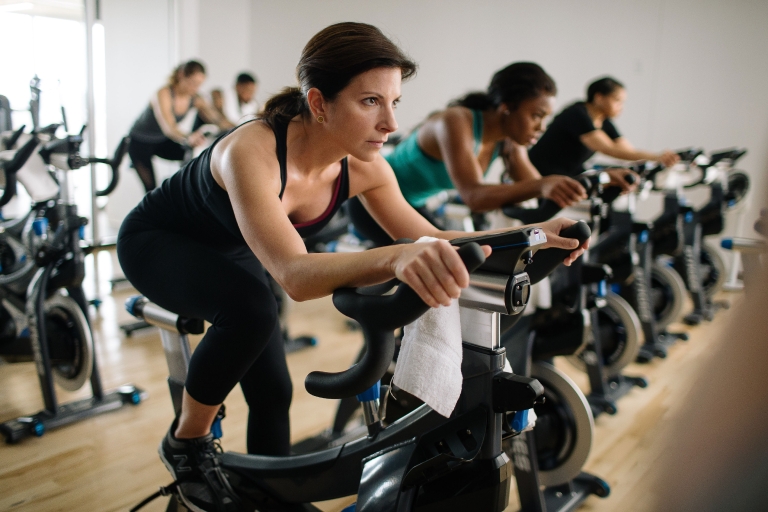It All Works Out: A Breakdown of Group Fitness Classes

You're exhausted. Sore. Foggy. You blearily squint at your phone, silencing its alarm as the day beckons. The last thing you want to do is move.
It's time to work out.
Exercise is a hangover in reverse – an hour or so of pain for all-day benefits: elevated mood, more energy, deeper sleep, less stress, a clearer mind, improved health, and a shapelier body. You're more productive at work. You're better with your family. Everything in life seems a little more possible in the wake of a wicked workout. In short, it's a wise investment. And stretched out on a long enough timeline, frequent exercising will give you longevity and a better chance at what we call happiness.
But few people look forward to a hangover. So, seeking your motivation for working out? Don't worry – you're not alone.
The Singular Success of Group Fitness
The group workout class remains a sanctuary in a secular tech world – when you step into that studio, you join a community of the fitness faithful hinged on movement. And no matter your exact reasons for being there – the summer body, adding years to your life, uncluttering your head – it's all part of the same tapestry of upgrading your existence.
Once it's all over, the wave of ecstatic mutual exhaustion and collective catharsis with strangers hits you – that shared blissed-out obliteration unnervingly primal (and accordingly, effective). Workout classes stoke one's intrinsic competitive fires and unveil accountability. Esteem meets aspiration covered in perspiration intertwined with the lost art of human connection, in this case – trauma bonding. In 2022, we do so few things together anymore, so why not hit up a Tabata class?
Many people operate like this now, with over half of exercisers swearing by the ritualized effectiveness of group workout sessions. Americans will rattle off the names and brands of their signature fitness experiences in the same breath as sharing their favorite streaming content (sometimes they overlap). "I'm going to binge Top Gun: Maverick right after Infantry Boot Camp."
People love them so much that some may existentially mull over: "If I worked out alone, did it even happen?
Alone Together: Group Workout Benefits
The Darwinian nature of besting (or at least keeping up with) everyone in class proves a potent motivator, but it's only part of what makes these sessions so staggeringly popular.
Accountability
Many trainers will often espouse the maxim, "Showing up is the most challenging part." While this may seem like a cutesy throwaway line, there's a truth that simply blocking off the time and getting yourself to class can remain the trickiest part in terms of sheer willpower. Once you're there, you stay locked into the rhythms of the session. You're kept honest not only by the instructor's gaze but also by the sweat and effort of your classmates. And even better – you could be that beacon of inspiration to others as you go all out – and they'll feed off your energy.
Focus
These sessions exist in a vacuum – you're not on your iPhone, checking Slack, Outlook, or shuffling through Spotify podcasts. There's no ESPN on mute in the background. Cutting through the digital chatter brings all your attention to the task at hand (or foot). You're also not freestyling your workout, wondering what machine to hit next as you aimlessly wander around a gym. The routine structure is both surgical and military in style, cutting all the fat from indecision so you can busy yourself burning yours.
Safety
Maybe the most overlooked perk of working out together – but the exact reason weightlifters have a spotter writ large. There's a small village of people (with one expert) there to help in an emergency. And with a structured framework led by a professional to guide you through sound warm-ups and cooldowns, consider possible injuries mitigated.
Taking Shape: A History of Group Workouts
These classes are so in vogue now that it feels like they've been around forever. As if there has always been a bevy of options at our fingertips and in our neighborhoods. But this phenomenon of ubiquitous fitness classes as we know it is only as old as a middle schooler.
Midcentury, the idea of exercise for civilians (non-athletes or soldiers) seemed dubious. People wanted to indulge in the fruits of their labor, relishing the post-WWII Americana affluence with Manhattans, Lucky Strikes, and London Broils. If they caught someone sprinting down the neighborhood road, the only reasonable excuse would be that someone was chasing them. Unless you were wearing Yankee pinstripes or off fighting in Korea, why pick up any unnecessary weights? And even then, the fitness standards for someone in the MLB or US Army fell precipitously lower than they are now (you think Mickey Mantle had abs?)
But in 1968, amid a tumult of cultural change, the low-key impetus of the 21st-century fitness boom arrived. Dr. Kenneth H. Cooper debuted Aerobics, a game-changing book for a fledgling industry, introducing the idea of exercise for the masses and highlighting the medically approved preventative health benefits.
This piece of literature gave the movement credibility, pivoting a sea change as the next few decades saw a wave of dance and biking-inspiring full-body and cardio workouts in Jazzercise, Zumba, and Spinning – the forebearers of 2022's group workout classes. And through the generations, this foundation found itself layered with newer additions: resistance training and the data-backed efficiency of HIIT (High-Intensity Interval Training), leading us to the optimal evolution of group fitness classes – the brand available at The St. James.
The St. James: The Future of Group Fitness
The Build, Burn, Recover methodology infused in the DNA of The St. James workouts classes offers a holistic program schedule that's a perfect fit for your body's needs, with complimentary, exclusive courses for members. As a reminder, this is how teams work out – together. And this is the driving ethos at The St. James, to kindle your inner athlete waiting to awaken.
Sports are so ingrained into our childhood, then often severed by the time we're in our 20s – but we still ache and yearn for the physicality and camaraderie of playing and performing like athletes. From an evolutionary vantage, we're born to move. And the more we get away from that, the less human we feel. Couple that with an information economy dictated by screens, and fewer of us have any manual part of our job – the only lift of your workweek may be perching your laptop upon a copy of Aerobics before a Zoom call.
Group workouts let you return to a more natural state, a more childlike one, but with the precision and efficacy of a polished professional. And beyond the beaucoup beneficial byproducts of group fitness, there's the act itself: you'll keep furthering your mastery. And there, in a crowded room, that's a victory that's yours alone.
Drenched in sweat, hunched over, and gasping for breath, you achingly glance to your side at a room filled with other willing masochists, their heaving, broken-down machinery mirroring yours. The last thing you want to do is move, but you can manage a hint of a smile.
It's time to finish your workout.
